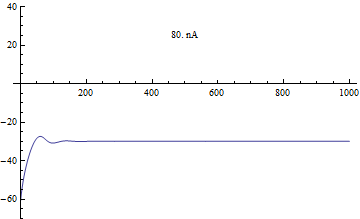 | ||
The Morris–Lecar model is a biological neuron model developed by Catherine Morris and Harold Lecar to reproduce the variety of oscillatory behavior in relation to Ca++ and K+ conductance in the muscle fiber of the giant barnacle . Morris–Lecar neurons exhibit both class I and class II neuron excitability.
Contents
History
Catherine Morris (b. 24 December 1949) is a Canadian biologist. She won a Commonwealth scholarship to study at Cambridge University, where she earned her PhD in 1977. She became a professor at the University of Ottawa in the early 1980s. As of 2015, she is an emeritus professor at the University of Ottawa. Harold Lecar (18 Oct 1935-4 Feb 2014) was an American professor of biophysics and neurobiology at the University of California Berkeley. He graduated with his PhD in physics from Columbia University in 1963.
Experimental method
The Morris–Lecar experiments relied on the current clamp method established by Keynes et al. (1973).
Large specimens of the barnacle Balanus nubilus (Pacific Bio-Marine Laboratories Inc., Venice, California) were used. The barnacle was sawed into lateral halves, and the depressor scutorum rostralis muscles were carefully exposed. Individual fibers were dissected, the incision starting from the tendon. The other end of the muscle was cut close to its attachment on the shell and ligatured. Isolated fibers were either used immediately or kept for up to 30 min in standard artificial seawater (ASW; see below) before use. Experiments were carried out at room temperature of 22 C.
The principal assumptions underlying the Morris–Lecar model include
- Equations apply to a spatially iso-potential patch of membrane. There are two persistent (non-inactivating) voltage-gated currents with oppositively biased reversal potentials. The depolarizing current is carried by Na+ or Ca2+ ions (or both), depending on the system to be modeled, and the hyperpolarizing current is carried by K+.
- Activation gates follow changes in membrane potential sufficiently rapidly that the activating conductance can instantaneously relax to its steady-state value at any voltage.
- The dynamics of the recovery variable can be approximated by a first-order linear differential equation for the probability of channel opening.
Physiological description
The Morris–Lecar model is a two-dimensional system of nonlinear differential equations. It is considered a simplified model compared to the four-dimensional Hodgkin–Huxley model.
Qualitatively, this system of equations describes the complex relationship between membrane potential and the activation of ion channels within the membrane: the potential depends on the activity of the ion channels, and the activity of the ion channels depends on the voltage. As bifurcation parameters are altered, different classes of neuron behavior are exhibited. τN is associated with the relative time scales of the firing dynamics, which varies broadly from cell to cell and exhibits significant temperature dependency.
Quantitatively:
where
Note that the Mss and Nss equations may also be expressed as Mss = (1 + Exp[-2(V - V1) / V2])−1 and Nss = (1 + Exp[-2(V - V3) / V4])−1, however most authors prefer the form using the hyperbolic functions.
Variables
Parameters and constants
Bifurcations
Bifurcation in the Morris–Lecar model have been analyzed with the applied current I, as the main bifurcation parameter and φ, gCa, V3, V4 as secondary parameters for phase plane analysis.
